Business Strategy: Macro Environment Analysis, SWOT Analysis, Porter's Five Forces Analysis, and Strategic Planning for Tesco
VerifiedAdded on 2023/01/17
|11
|2653
|20
AI Summary
This report analyzes the macro environment, SWOT analysis, Porter's Five Forces analysis, and strategic planning for Tesco, a multinational retailing company in the UK. It discusses the factors that affect the company's strategies and provides insights into its future business performance.
Contribute Materials
Your contribution can guide someone’s learning journey. Share your
documents today.
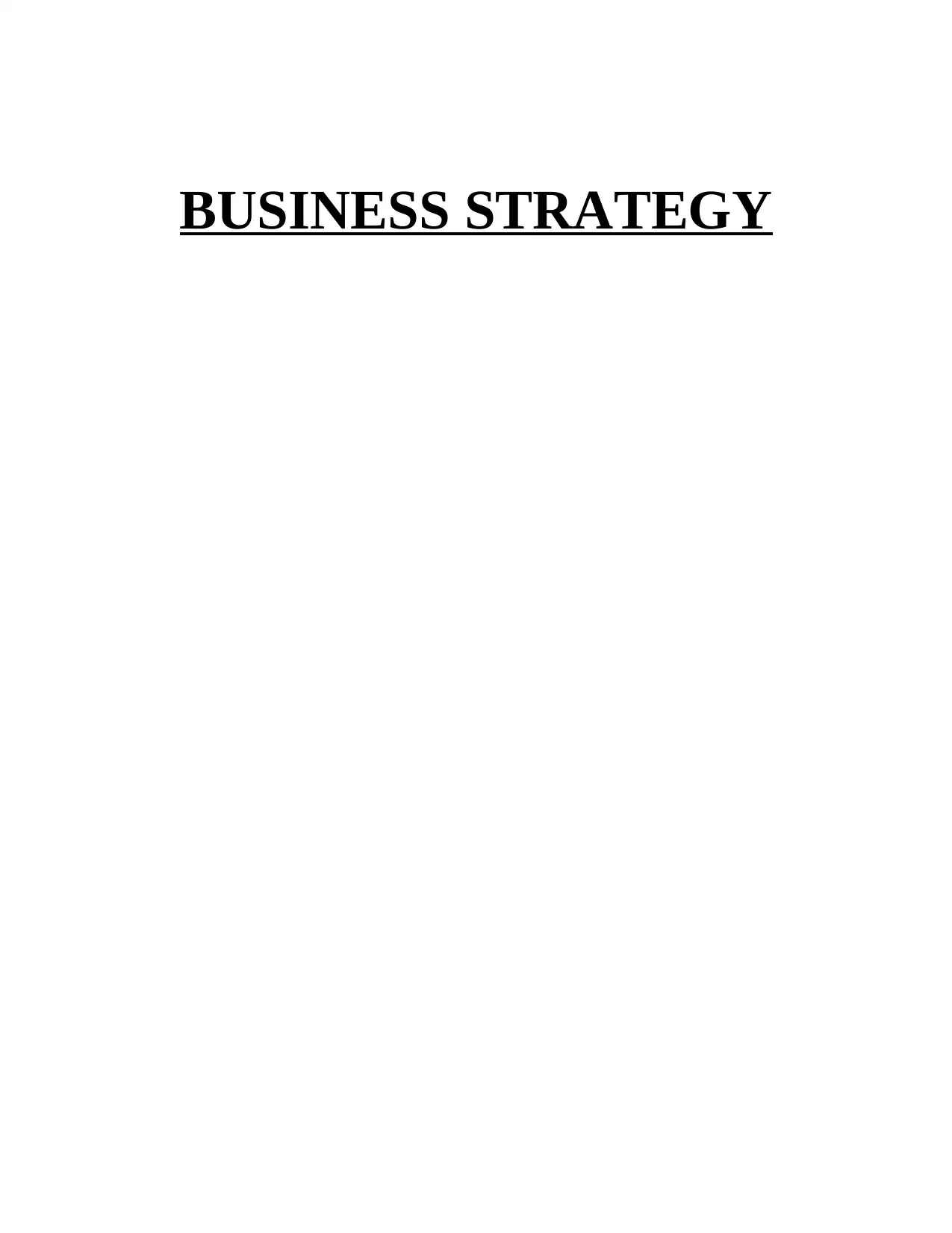
BUSINESS STRATEGY
Secure Best Marks with AI Grader
Need help grading? Try our AI Grader for instant feedback on your assignments.
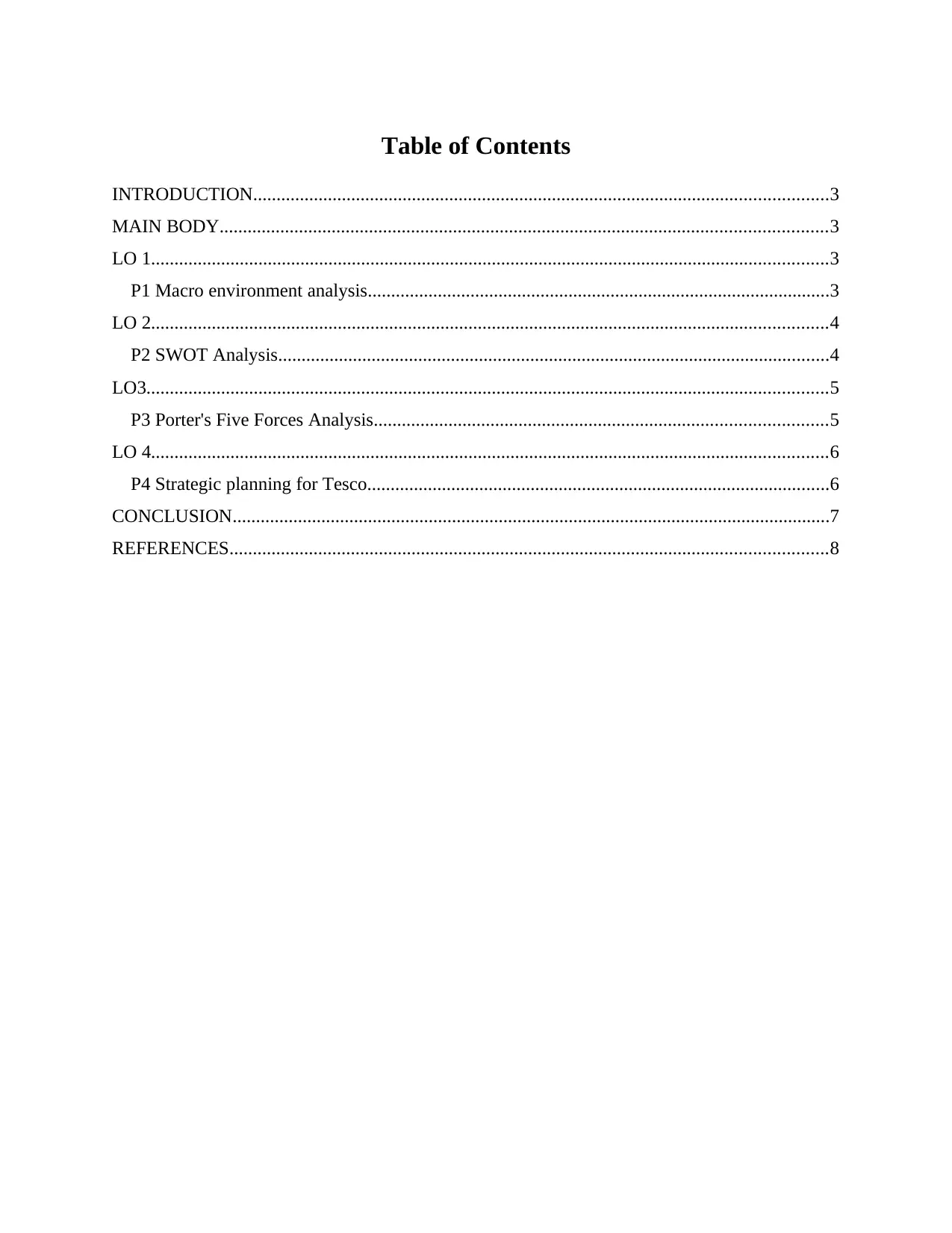
Table of Contents
INTRODUCTION...........................................................................................................................3
MAIN BODY..................................................................................................................................3
LO 1.................................................................................................................................................3
P1 Macro environment analysis...................................................................................................3
LO 2.................................................................................................................................................4
P2 SWOT Analysis......................................................................................................................4
LO3..................................................................................................................................................5
P3 Porter's Five Forces Analysis.................................................................................................5
LO 4.................................................................................................................................................6
P4 Strategic planning for Tesco...................................................................................................6
CONCLUSION................................................................................................................................7
REFERENCES................................................................................................................................8
INTRODUCTION...........................................................................................................................3
MAIN BODY..................................................................................................................................3
LO 1.................................................................................................................................................3
P1 Macro environment analysis...................................................................................................3
LO 2.................................................................................................................................................4
P2 SWOT Analysis......................................................................................................................4
LO3..................................................................................................................................................5
P3 Porter's Five Forces Analysis.................................................................................................5
LO 4.................................................................................................................................................6
P4 Strategic planning for Tesco...................................................................................................6
CONCLUSION................................................................................................................................7
REFERENCES................................................................................................................................8
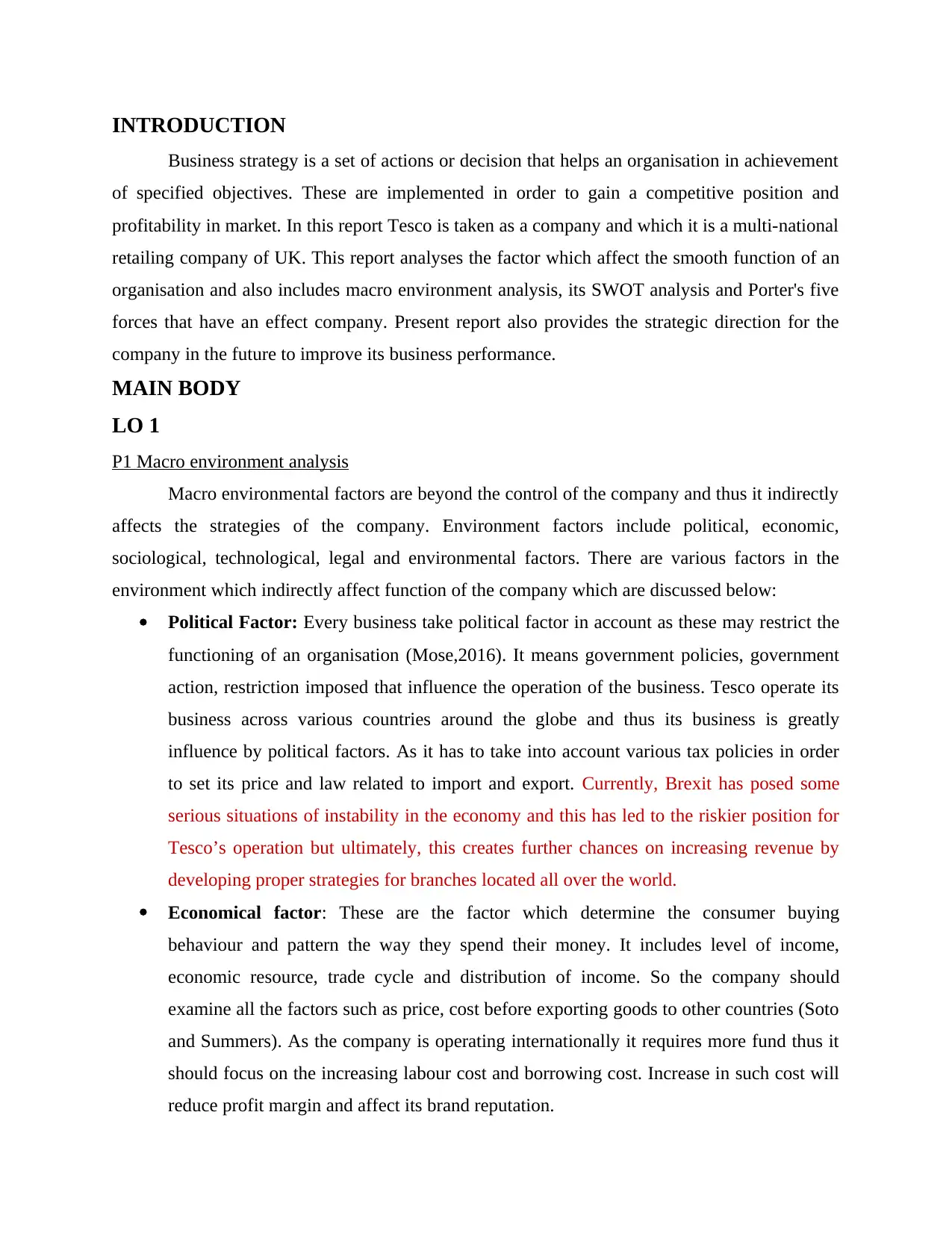
INTRODUCTION
Business strategy is a set of actions or decision that helps an organisation in achievement
of specified objectives. These are implemented in order to gain a competitive position and
profitability in market. In this report Tesco is taken as a company and which it is a multi-national
retailing company of UK. This report analyses the factor which affect the smooth function of an
organisation and also includes macro environment analysis, its SWOT analysis and Porter's five
forces that have an effect company. Present report also provides the strategic direction for the
company in the future to improve its business performance.
MAIN BODY
LO 1
P1 Macro environment analysis
Macro environmental factors are beyond the control of the company and thus it indirectly
affects the strategies of the company. Environment factors include political, economic,
sociological, technological, legal and environmental factors. There are various factors in the
environment which indirectly affect function of the company which are discussed below:
Political Factor: Every business take political factor in account as these may restrict the
functioning of an organisation (Mose,2016). It means government policies, government
action, restriction imposed that influence the operation of the business. Tesco operate its
business across various countries around the globe and thus its business is greatly
influence by political factors. As it has to take into account various tax policies in order
to set its price and law related to import and export. Currently, Brexit has posed some
serious situations of instability in the economy and this has led to the riskier position for
Tesco’s operation but ultimately, this creates further chances on increasing revenue by
developing proper strategies for branches located all over the world.
Economical factor: These are the factor which determine the consumer buying
behaviour and pattern the way they spend their money. It includes level of income,
economic resource, trade cycle and distribution of income. So the company should
examine all the factors such as price, cost before exporting goods to other countries (Soto
and Summers). As the company is operating internationally it requires more fund thus it
should focus on the increasing labour cost and borrowing cost. Increase in such cost will
reduce profit margin and affect its brand reputation.
Business strategy is a set of actions or decision that helps an organisation in achievement
of specified objectives. These are implemented in order to gain a competitive position and
profitability in market. In this report Tesco is taken as a company and which it is a multi-national
retailing company of UK. This report analyses the factor which affect the smooth function of an
organisation and also includes macro environment analysis, its SWOT analysis and Porter's five
forces that have an effect company. Present report also provides the strategic direction for the
company in the future to improve its business performance.
MAIN BODY
LO 1
P1 Macro environment analysis
Macro environmental factors are beyond the control of the company and thus it indirectly
affects the strategies of the company. Environment factors include political, economic,
sociological, technological, legal and environmental factors. There are various factors in the
environment which indirectly affect function of the company which are discussed below:
Political Factor: Every business take political factor in account as these may restrict the
functioning of an organisation (Mose,2016). It means government policies, government
action, restriction imposed that influence the operation of the business. Tesco operate its
business across various countries around the globe and thus its business is greatly
influence by political factors. As it has to take into account various tax policies in order
to set its price and law related to import and export. Currently, Brexit has posed some
serious situations of instability in the economy and this has led to the riskier position for
Tesco’s operation but ultimately, this creates further chances on increasing revenue by
developing proper strategies for branches located all over the world.
Economical factor: These are the factor which determine the consumer buying
behaviour and pattern the way they spend their money. It includes level of income,
economic resource, trade cycle and distribution of income. So the company should
examine all the factors such as price, cost before exporting goods to other countries (Soto
and Summers). As the company is operating internationally it requires more fund thus it
should focus on the increasing labour cost and borrowing cost. Increase in such cost will
reduce profit margin and affect its brand reputation.
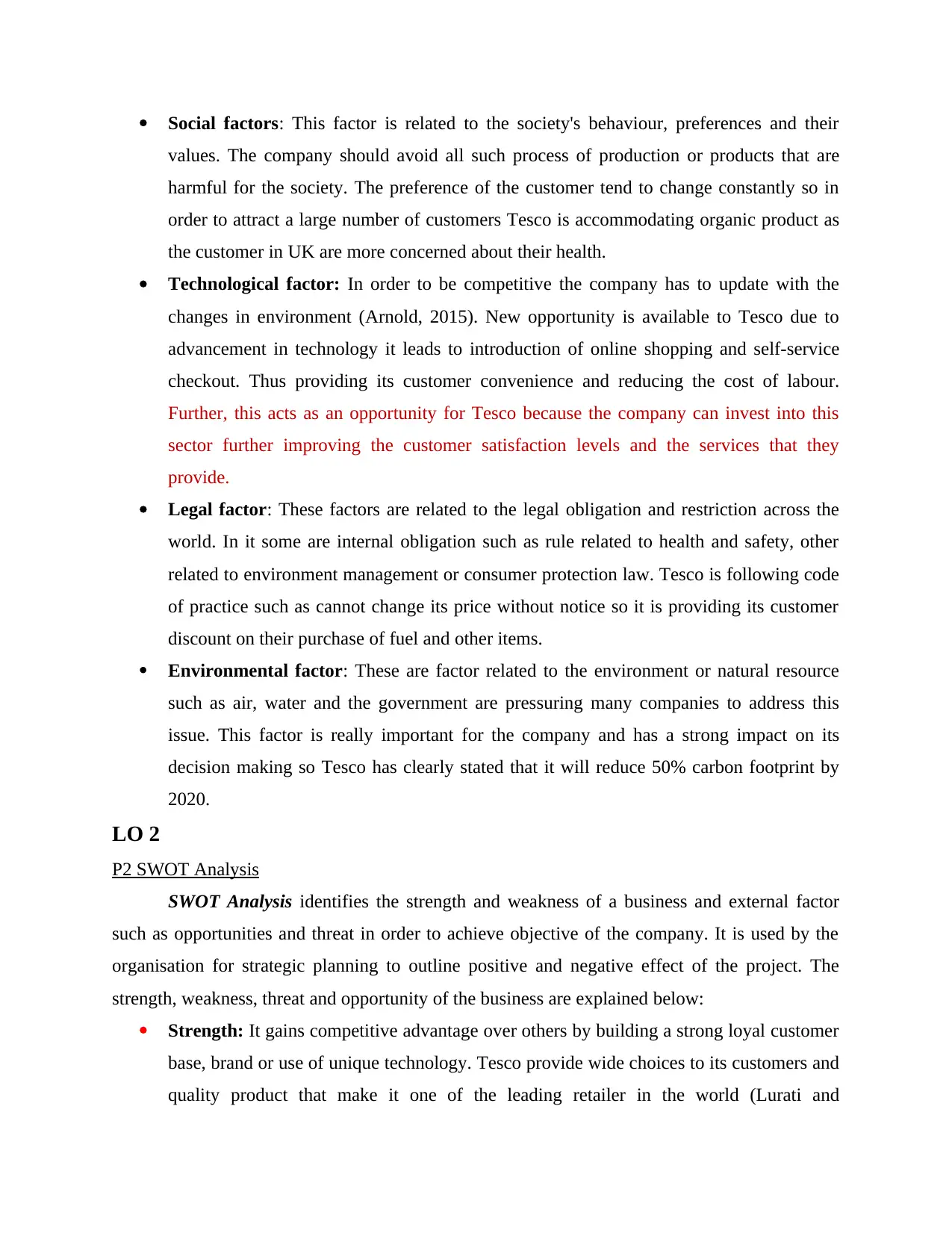
Social factors: This factor is related to the society's behaviour, preferences and their
values. The company should avoid all such process of production or products that are
harmful for the society. The preference of the customer tend to change constantly so in
order to attract a large number of customers Tesco is accommodating organic product as
the customer in UK are more concerned about their health.
Technological factor: In order to be competitive the company has to update with the
changes in environment (Arnold, 2015). New opportunity is available to Tesco due to
advancement in technology it leads to introduction of online shopping and self-service
checkout. Thus providing its customer convenience and reducing the cost of labour.
Further, this acts as an opportunity for Tesco because the company can invest into this
sector further improving the customer satisfaction levels and the services that they
provide.
Legal factor: These factors are related to the legal obligation and restriction across the
world. In it some are internal obligation such as rule related to health and safety, other
related to environment management or consumer protection law. Tesco is following code
of practice such as cannot change its price without notice so it is providing its customer
discount on their purchase of fuel and other items.
Environmental factor: These are factor related to the environment or natural resource
such as air, water and the government are pressuring many companies to address this
issue. This factor is really important for the company and has a strong impact on its
decision making so Tesco has clearly stated that it will reduce 50% carbon footprint by
2020.
LO 2
P2 SWOT Analysis
SWOT Analysis identifies the strength and weakness of a business and external factor
such as opportunities and threat in order to achieve objective of the company. It is used by the
organisation for strategic planning to outline positive and negative effect of the project. The
strength, weakness, threat and opportunity of the business are explained below:
Strength: It gains competitive advantage over others by building a strong loyal customer
base, brand or use of unique technology. Tesco provide wide choices to its customers and
quality product that make it one of the leading retailer in the world (Lurati and
values. The company should avoid all such process of production or products that are
harmful for the society. The preference of the customer tend to change constantly so in
order to attract a large number of customers Tesco is accommodating organic product as
the customer in UK are more concerned about their health.
Technological factor: In order to be competitive the company has to update with the
changes in environment (Arnold, 2015). New opportunity is available to Tesco due to
advancement in technology it leads to introduction of online shopping and self-service
checkout. Thus providing its customer convenience and reducing the cost of labour.
Further, this acts as an opportunity for Tesco because the company can invest into this
sector further improving the customer satisfaction levels and the services that they
provide.
Legal factor: These factors are related to the legal obligation and restriction across the
world. In it some are internal obligation such as rule related to health and safety, other
related to environment management or consumer protection law. Tesco is following code
of practice such as cannot change its price without notice so it is providing its customer
discount on their purchase of fuel and other items.
Environmental factor: These are factor related to the environment or natural resource
such as air, water and the government are pressuring many companies to address this
issue. This factor is really important for the company and has a strong impact on its
decision making so Tesco has clearly stated that it will reduce 50% carbon footprint by
2020.
LO 2
P2 SWOT Analysis
SWOT Analysis identifies the strength and weakness of a business and external factor
such as opportunities and threat in order to achieve objective of the company. It is used by the
organisation for strategic planning to outline positive and negative effect of the project. The
strength, weakness, threat and opportunity of the business are explained below:
Strength: It gains competitive advantage over others by building a strong loyal customer
base, brand or use of unique technology. Tesco provide wide choices to its customers and
quality product that make it one of the leading retailer in the world (Lurati and
Secure Best Marks with AI Grader
Need help grading? Try our AI Grader for instant feedback on your assignments.
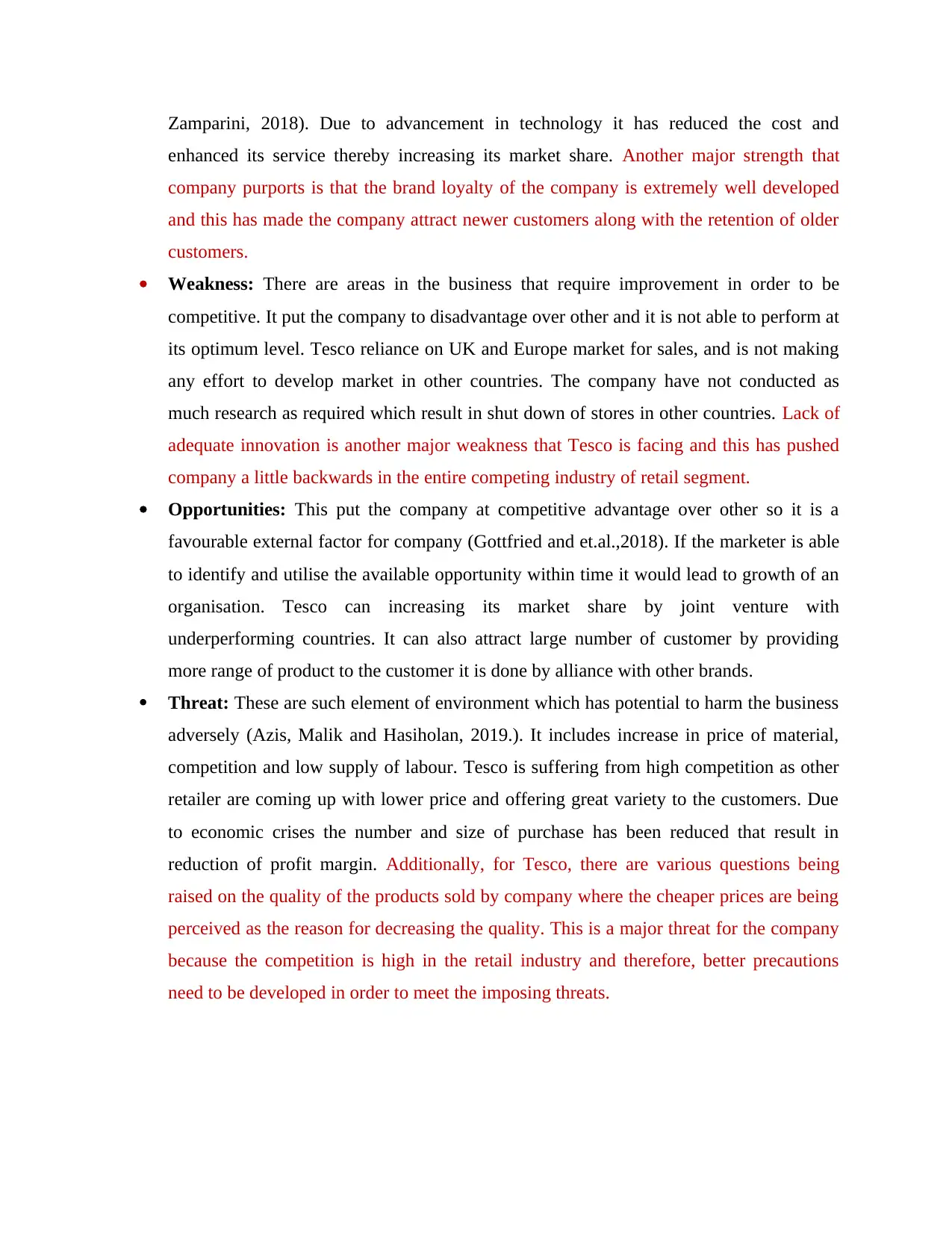
Zamparini, 2018). Due to advancement in technology it has reduced the cost and
enhanced its service thereby increasing its market share. Another major strength that
company purports is that the brand loyalty of the company is extremely well developed
and this has made the company attract newer customers along with the retention of older
customers.
Weakness: There are areas in the business that require improvement in order to be
competitive. It put the company to disadvantage over other and it is not able to perform at
its optimum level. Tesco reliance on UK and Europe market for sales, and is not making
any effort to develop market in other countries. The company have not conducted as
much research as required which result in shut down of stores in other countries. Lack of
adequate innovation is another major weakness that Tesco is facing and this has pushed
company a little backwards in the entire competing industry of retail segment.
Opportunities: This put the company at competitive advantage over other so it is a
favourable external factor for company (Gottfried and et.al.,2018). If the marketer is able
to identify and utilise the available opportunity within time it would lead to growth of an
organisation. Tesco can increasing its market share by joint venture with
underperforming countries. It can also attract large number of customer by providing
more range of product to the customer it is done by alliance with other brands.
Threat: These are such element of environment which has potential to harm the business
adversely (Azis, Malik and Hasiholan, 2019.). It includes increase in price of material,
competition and low supply of labour. Tesco is suffering from high competition as other
retailer are coming up with lower price and offering great variety to the customers. Due
to economic crises the number and size of purchase has been reduced that result in
reduction of profit margin. Additionally, for Tesco, there are various questions being
raised on the quality of the products sold by company where the cheaper prices are being
perceived as the reason for decreasing the quality. This is a major threat for the company
because the competition is high in the retail industry and therefore, better precautions
need to be developed in order to meet the imposing threats.
enhanced its service thereby increasing its market share. Another major strength that
company purports is that the brand loyalty of the company is extremely well developed
and this has made the company attract newer customers along with the retention of older
customers.
Weakness: There are areas in the business that require improvement in order to be
competitive. It put the company to disadvantage over other and it is not able to perform at
its optimum level. Tesco reliance on UK and Europe market for sales, and is not making
any effort to develop market in other countries. The company have not conducted as
much research as required which result in shut down of stores in other countries. Lack of
adequate innovation is another major weakness that Tesco is facing and this has pushed
company a little backwards in the entire competing industry of retail segment.
Opportunities: This put the company at competitive advantage over other so it is a
favourable external factor for company (Gottfried and et.al.,2018). If the marketer is able
to identify and utilise the available opportunity within time it would lead to growth of an
organisation. Tesco can increasing its market share by joint venture with
underperforming countries. It can also attract large number of customer by providing
more range of product to the customer it is done by alliance with other brands.
Threat: These are such element of environment which has potential to harm the business
adversely (Azis, Malik and Hasiholan, 2019.). It includes increase in price of material,
competition and low supply of labour. Tesco is suffering from high competition as other
retailer are coming up with lower price and offering great variety to the customers. Due
to economic crises the number and size of purchase has been reduced that result in
reduction of profit margin. Additionally, for Tesco, there are various questions being
raised on the quality of the products sold by company where the cheaper prices are being
perceived as the reason for decreasing the quality. This is a major threat for the company
because the competition is high in the retail industry and therefore, better precautions
need to be developed in order to meet the imposing threats.
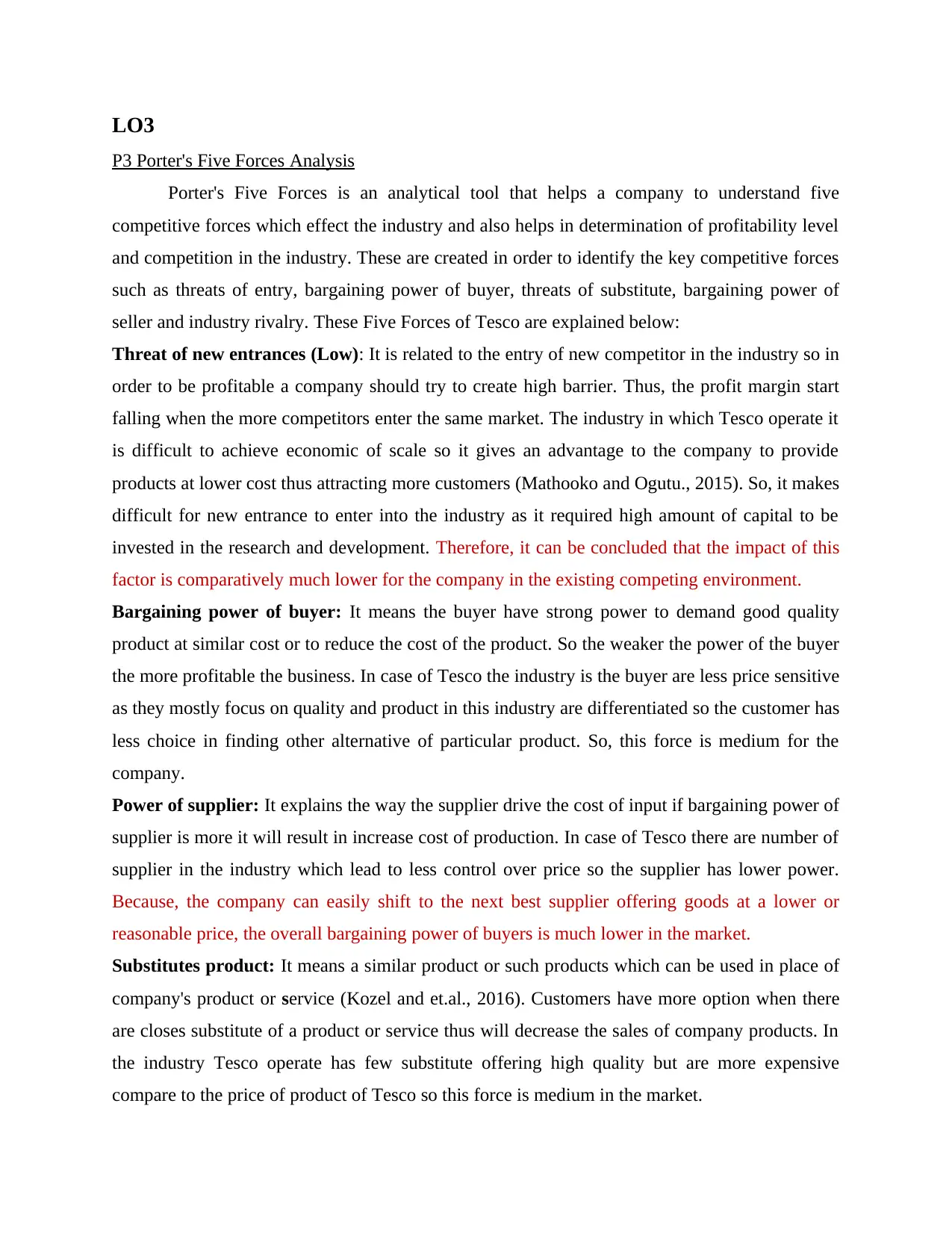
LO3
P3 Porter's Five Forces Analysis
Porter's Five Forces is an analytical tool that helps a company to understand five
competitive forces which effect the industry and also helps in determination of profitability level
and competition in the industry. These are created in order to identify the key competitive forces
such as threats of entry, bargaining power of buyer, threats of substitute, bargaining power of
seller and industry rivalry. These Five Forces of Tesco are explained below:
Threat of new entrances (Low): It is related to the entry of new competitor in the industry so in
order to be profitable a company should try to create high barrier. Thus, the profit margin start
falling when the more competitors enter the same market. The industry in which Tesco operate it
is difficult to achieve economic of scale so it gives an advantage to the company to provide
products at lower cost thus attracting more customers (Mathooko and Ogutu., 2015). So, it makes
difficult for new entrance to enter into the industry as it required high amount of capital to be
invested in the research and development. Therefore, it can be concluded that the impact of this
factor is comparatively much lower for the company in the existing competing environment.
Bargaining power of buyer: It means the buyer have strong power to demand good quality
product at similar cost or to reduce the cost of the product. So the weaker the power of the buyer
the more profitable the business. In case of Tesco the industry is the buyer are less price sensitive
as they mostly focus on quality and product in this industry are differentiated so the customer has
less choice in finding other alternative of particular product. So, this force is medium for the
company.
Power of supplier: It explains the way the supplier drive the cost of input if bargaining power of
supplier is more it will result in increase cost of production. In case of Tesco there are number of
supplier in the industry which lead to less control over price so the supplier has lower power.
Because, the company can easily shift to the next best supplier offering goods at a lower or
reasonable price, the overall bargaining power of buyers is much lower in the market.
Substitutes product: It means a similar product or such products which can be used in place of
company's product or service (Kozel and et.al., 2016). Customers have more option when there
are closes substitute of a product or service thus will decrease the sales of company products. In
the industry Tesco operate has few substitute offering high quality but are more expensive
compare to the price of product of Tesco so this force is medium in the market.
P3 Porter's Five Forces Analysis
Porter's Five Forces is an analytical tool that helps a company to understand five
competitive forces which effect the industry and also helps in determination of profitability level
and competition in the industry. These are created in order to identify the key competitive forces
such as threats of entry, bargaining power of buyer, threats of substitute, bargaining power of
seller and industry rivalry. These Five Forces of Tesco are explained below:
Threat of new entrances (Low): It is related to the entry of new competitor in the industry so in
order to be profitable a company should try to create high barrier. Thus, the profit margin start
falling when the more competitors enter the same market. The industry in which Tesco operate it
is difficult to achieve economic of scale so it gives an advantage to the company to provide
products at lower cost thus attracting more customers (Mathooko and Ogutu., 2015). So, it makes
difficult for new entrance to enter into the industry as it required high amount of capital to be
invested in the research and development. Therefore, it can be concluded that the impact of this
factor is comparatively much lower for the company in the existing competing environment.
Bargaining power of buyer: It means the buyer have strong power to demand good quality
product at similar cost or to reduce the cost of the product. So the weaker the power of the buyer
the more profitable the business. In case of Tesco the industry is the buyer are less price sensitive
as they mostly focus on quality and product in this industry are differentiated so the customer has
less choice in finding other alternative of particular product. So, this force is medium for the
company.
Power of supplier: It explains the way the supplier drive the cost of input if bargaining power of
supplier is more it will result in increase cost of production. In case of Tesco there are number of
supplier in the industry which lead to less control over price so the supplier has lower power.
Because, the company can easily shift to the next best supplier offering goods at a lower or
reasonable price, the overall bargaining power of buyers is much lower in the market.
Substitutes product: It means a similar product or such products which can be used in place of
company's product or service (Kozel and et.al., 2016). Customers have more option when there
are closes substitute of a product or service thus will decrease the sales of company products. In
the industry Tesco operate has few substitute offering high quality but are more expensive
compare to the price of product of Tesco so this force is medium in the market.
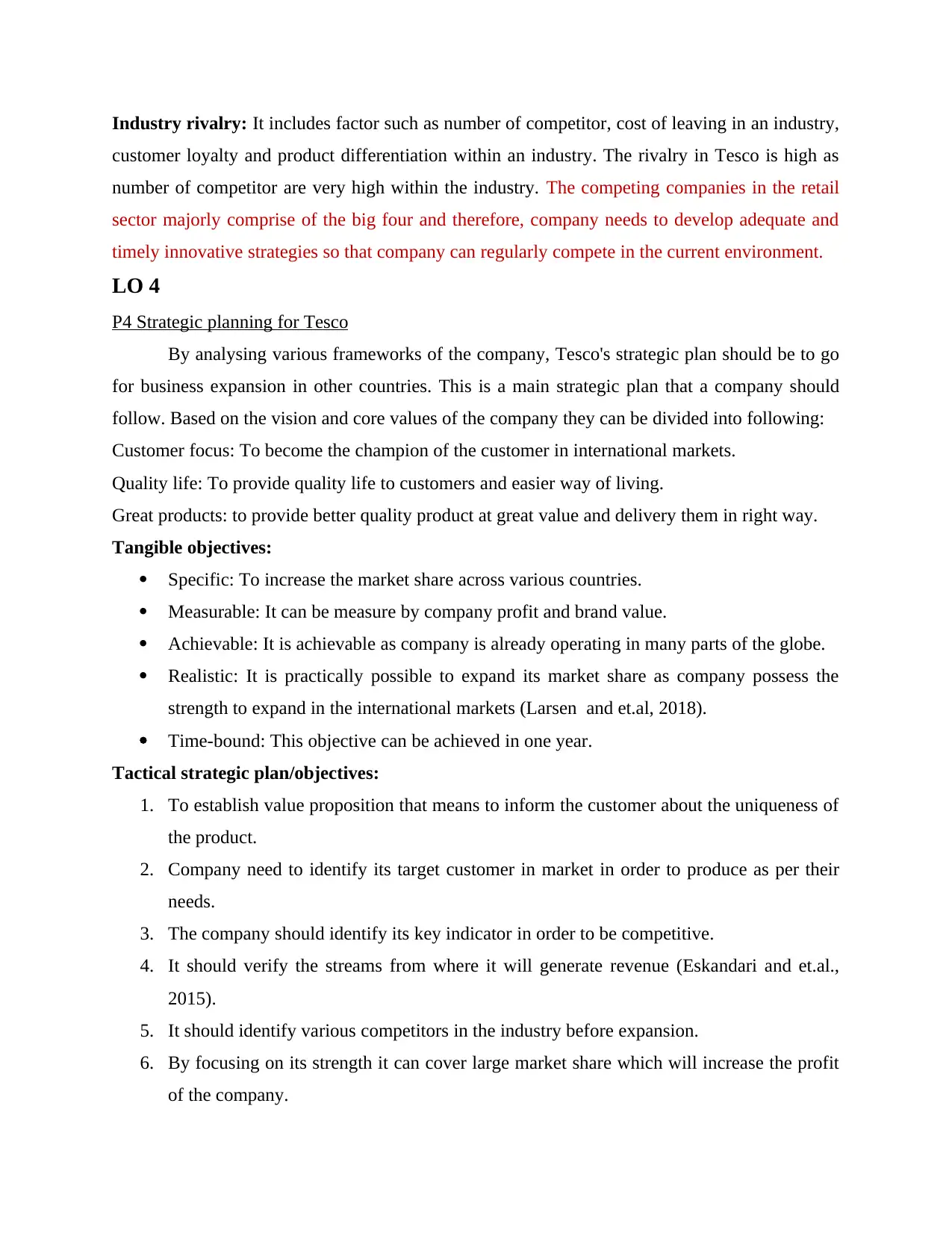
Industry rivalry: It includes factor such as number of competitor, cost of leaving in an industry,
customer loyalty and product differentiation within an industry. The rivalry in Tesco is high as
number of competitor are very high within the industry. The competing companies in the retail
sector majorly comprise of the big four and therefore, company needs to develop adequate and
timely innovative strategies so that company can regularly compete in the current environment.
LO 4
P4 Strategic planning for Tesco
By analysing various frameworks of the company, Tesco's strategic plan should be to go
for business expansion in other countries. This is a main strategic plan that a company should
follow. Based on the vision and core values of the company they can be divided into following:
Customer focus: To become the champion of the customer in international markets.
Quality life: To provide quality life to customers and easier way of living.
Great products: to provide better quality product at great value and delivery them in right way.
Tangible objectives:
Specific: To increase the market share across various countries.
Measurable: It can be measure by company profit and brand value.
Achievable: It is achievable as company is already operating in many parts of the globe.
Realistic: It is practically possible to expand its market share as company possess the
strength to expand in the international markets (Larsen and et.al, 2018).
Time-bound: This objective can be achieved in one year.
Tactical strategic plan/objectives:
1. To establish value proposition that means to inform the customer about the uniqueness of
the product.
2. Company need to identify its target customer in market in order to produce as per their
needs.
3. The company should identify its key indicator in order to be competitive.
4. It should verify the streams from where it will generate revenue (Eskandari and et.al.,
2015).
5. It should identify various competitors in the industry before expansion.
6. By focusing on its strength it can cover large market share which will increase the profit
of the company.
customer loyalty and product differentiation within an industry. The rivalry in Tesco is high as
number of competitor are very high within the industry. The competing companies in the retail
sector majorly comprise of the big four and therefore, company needs to develop adequate and
timely innovative strategies so that company can regularly compete in the current environment.
LO 4
P4 Strategic planning for Tesco
By analysing various frameworks of the company, Tesco's strategic plan should be to go
for business expansion in other countries. This is a main strategic plan that a company should
follow. Based on the vision and core values of the company they can be divided into following:
Customer focus: To become the champion of the customer in international markets.
Quality life: To provide quality life to customers and easier way of living.
Great products: to provide better quality product at great value and delivery them in right way.
Tangible objectives:
Specific: To increase the market share across various countries.
Measurable: It can be measure by company profit and brand value.
Achievable: It is achievable as company is already operating in many parts of the globe.
Realistic: It is practically possible to expand its market share as company possess the
strength to expand in the international markets (Larsen and et.al, 2018).
Time-bound: This objective can be achieved in one year.
Tactical strategic plan/objectives:
1. To establish value proposition that means to inform the customer about the uniqueness of
the product.
2. Company need to identify its target customer in market in order to produce as per their
needs.
3. The company should identify its key indicator in order to be competitive.
4. It should verify the streams from where it will generate revenue (Eskandari and et.al.,
2015).
5. It should identify various competitors in the industry before expansion.
6. By focusing on its strength it can cover large market share which will increase the profit
of the company.
Paraphrase This Document
Need a fresh take? Get an instant paraphrase of this document with our AI Paraphraser
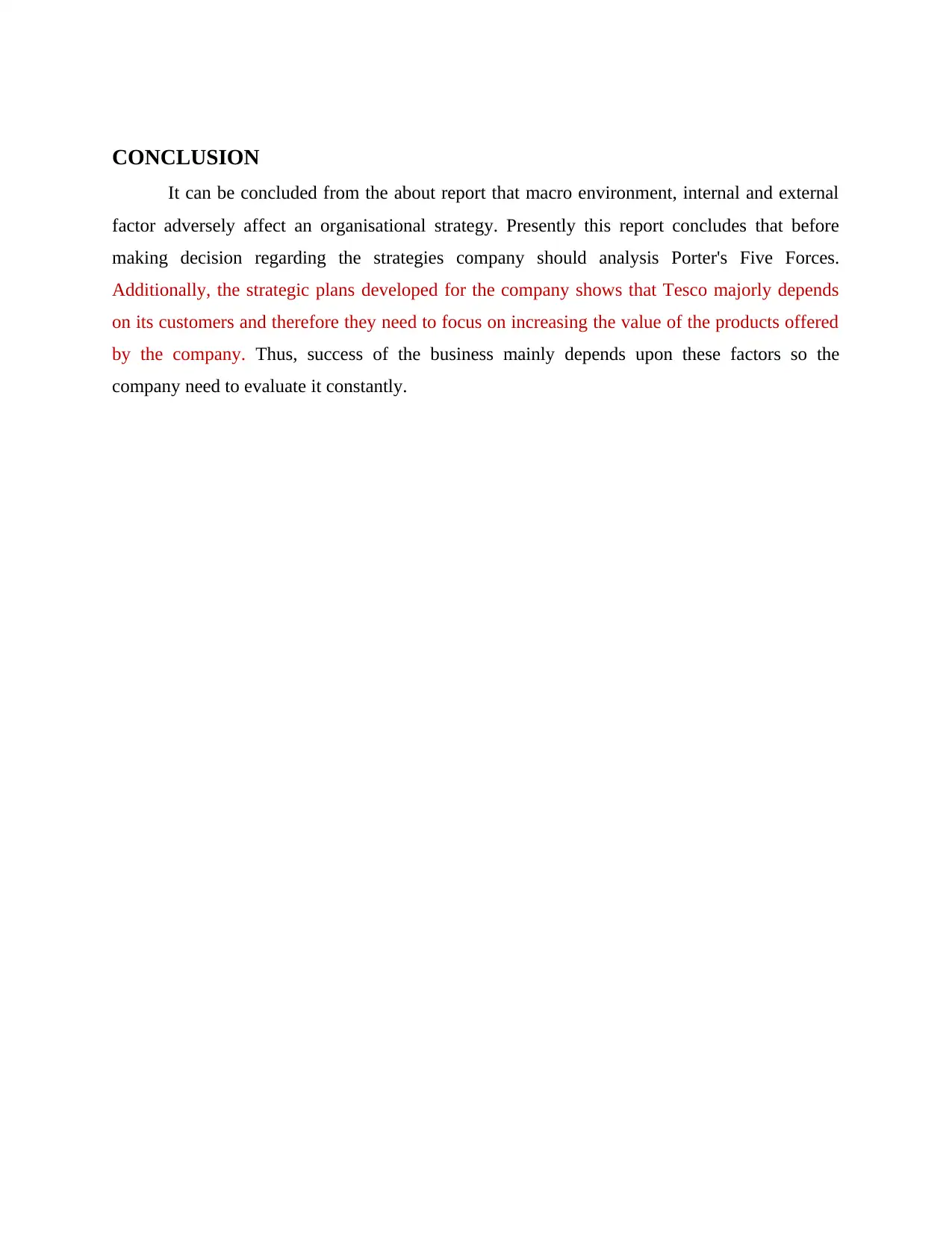
CONCLUSION
It can be concluded from the about report that macro environment, internal and external
factor adversely affect an organisational strategy. Presently this report concludes that before
making decision regarding the strategies company should analysis Porter's Five Forces.
Additionally, the strategic plans developed for the company shows that Tesco majorly depends
on its customers and therefore they need to focus on increasing the value of the products offered
by the company. Thus, success of the business mainly depends upon these factors so the
company need to evaluate it constantly.
It can be concluded from the about report that macro environment, internal and external
factor adversely affect an organisational strategy. Presently this report concludes that before
making decision regarding the strategies company should analysis Porter's Five Forces.
Additionally, the strategic plans developed for the company shows that Tesco majorly depends
on its customers and therefore they need to focus on increasing the value of the products offered
by the company. Thus, success of the business mainly depends upon these factors so the
company need to evaluate it constantly.
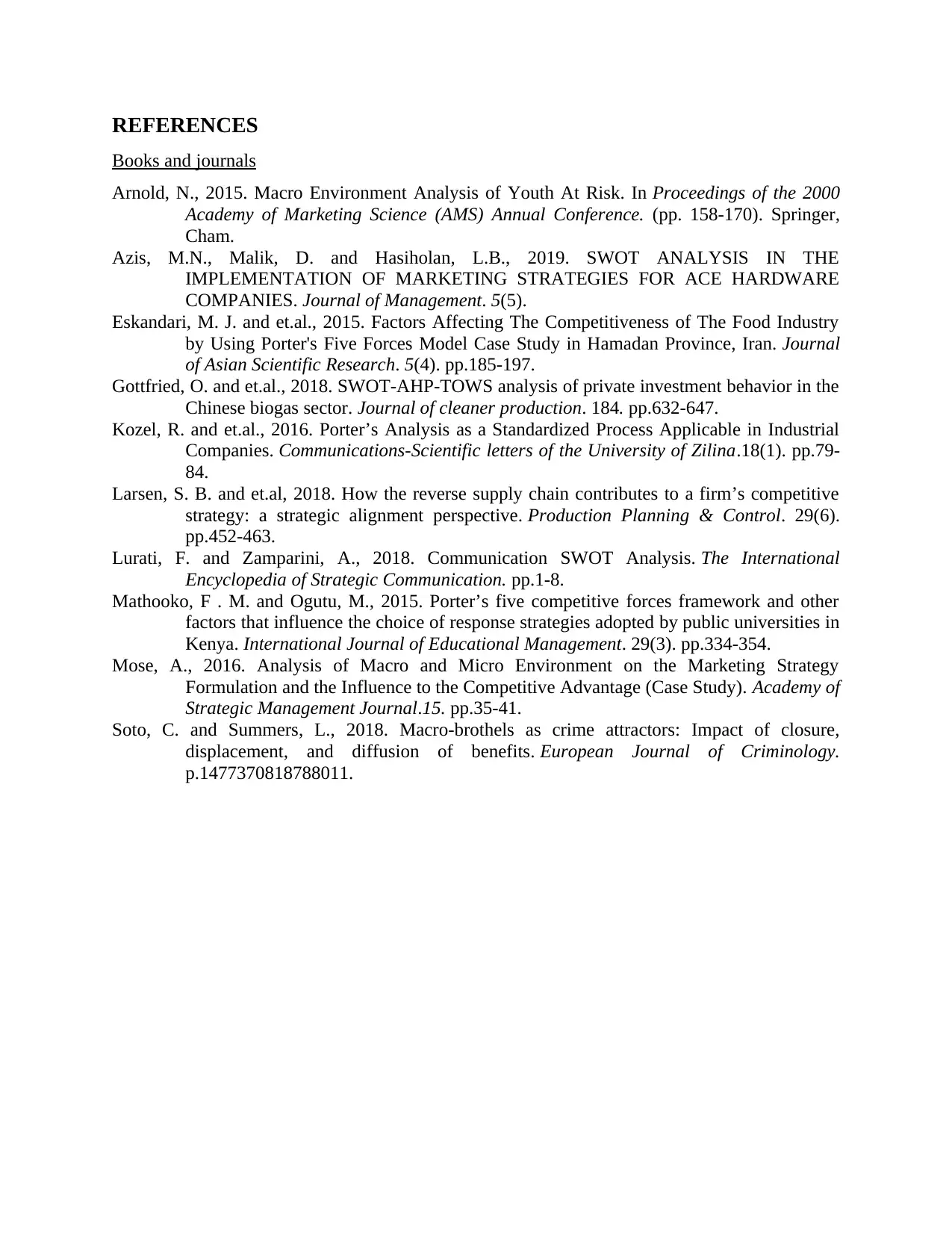
REFERENCES
Books and journals
Arnold, N., 2015. Macro Environment Analysis of Youth At Risk. In Proceedings of the 2000
Academy of Marketing Science (AMS) Annual Conference. (pp. 158-170). Springer,
Cham.
Azis, M.N., Malik, D. and Hasiholan, L.B., 2019. SWOT ANALYSIS IN THE
IMPLEMENTATION OF MARKETING STRATEGIES FOR ACE HARDWARE
COMPANIES. Journal of Management. 5(5).
Eskandari, M. J. and et.al., 2015. Factors Affecting The Competitiveness of The Food Industry
by Using Porter's Five Forces Model Case Study in Hamadan Province, Iran. Journal
of Asian Scientific Research. 5(4). pp.185-197.
Gottfried, O. and et.al., 2018. SWOT-AHP-TOWS analysis of private investment behavior in the
Chinese biogas sector. Journal of cleaner production. 184. pp.632-647.
Kozel, R. and et.al., 2016. Porter’s Analysis as a Standardized Process Applicable in Industrial
Companies. Communications-Scientific letters of the University of Zilina.18(1). pp.79-
84.
Larsen, S. B. and et.al, 2018. How the reverse supply chain contributes to a firm’s competitive
strategy: a strategic alignment perspective. Production Planning & Control. 29(6).
pp.452-463.
Lurati, F. and Zamparini, A., 2018. Communication SWOT Analysis. The International
Encyclopedia of Strategic Communication. pp.1-8.
Mathooko, F . M. and Ogutu, M., 2015. Porter’s five competitive forces framework and other
factors that influence the choice of response strategies adopted by public universities in
Kenya. International Journal of Educational Management. 29(3). pp.334-354.
Mose, A., 2016. Analysis of Macro and Micro Environment on the Marketing Strategy
Formulation and the Influence to the Competitive Advantage (Case Study). Academy of
Strategic Management Journal.15. pp.35-41.
Soto, C. and Summers, L., 2018. Macro-brothels as crime attractors: Impact of closure,
displacement, and diffusion of benefits. European Journal of Criminology.
p.1477370818788011.
Books and journals
Arnold, N., 2015. Macro Environment Analysis of Youth At Risk. In Proceedings of the 2000
Academy of Marketing Science (AMS) Annual Conference. (pp. 158-170). Springer,
Cham.
Azis, M.N., Malik, D. and Hasiholan, L.B., 2019. SWOT ANALYSIS IN THE
IMPLEMENTATION OF MARKETING STRATEGIES FOR ACE HARDWARE
COMPANIES. Journal of Management. 5(5).
Eskandari, M. J. and et.al., 2015. Factors Affecting The Competitiveness of The Food Industry
by Using Porter's Five Forces Model Case Study in Hamadan Province, Iran. Journal
of Asian Scientific Research. 5(4). pp.185-197.
Gottfried, O. and et.al., 2018. SWOT-AHP-TOWS analysis of private investment behavior in the
Chinese biogas sector. Journal of cleaner production. 184. pp.632-647.
Kozel, R. and et.al., 2016. Porter’s Analysis as a Standardized Process Applicable in Industrial
Companies. Communications-Scientific letters of the University of Zilina.18(1). pp.79-
84.
Larsen, S. B. and et.al, 2018. How the reverse supply chain contributes to a firm’s competitive
strategy: a strategic alignment perspective. Production Planning & Control. 29(6).
pp.452-463.
Lurati, F. and Zamparini, A., 2018. Communication SWOT Analysis. The International
Encyclopedia of Strategic Communication. pp.1-8.
Mathooko, F . M. and Ogutu, M., 2015. Porter’s five competitive forces framework and other
factors that influence the choice of response strategies adopted by public universities in
Kenya. International Journal of Educational Management. 29(3). pp.334-354.
Mose, A., 2016. Analysis of Macro and Micro Environment on the Marketing Strategy
Formulation and the Influence to the Competitive Advantage (Case Study). Academy of
Strategic Management Journal.15. pp.35-41.
Soto, C. and Summers, L., 2018. Macro-brothels as crime attractors: Impact of closure,
displacement, and diffusion of benefits. European Journal of Criminology.
p.1477370818788011.

Secure Best Marks with AI Grader
Need help grading? Try our AI Grader for instant feedback on your assignments.
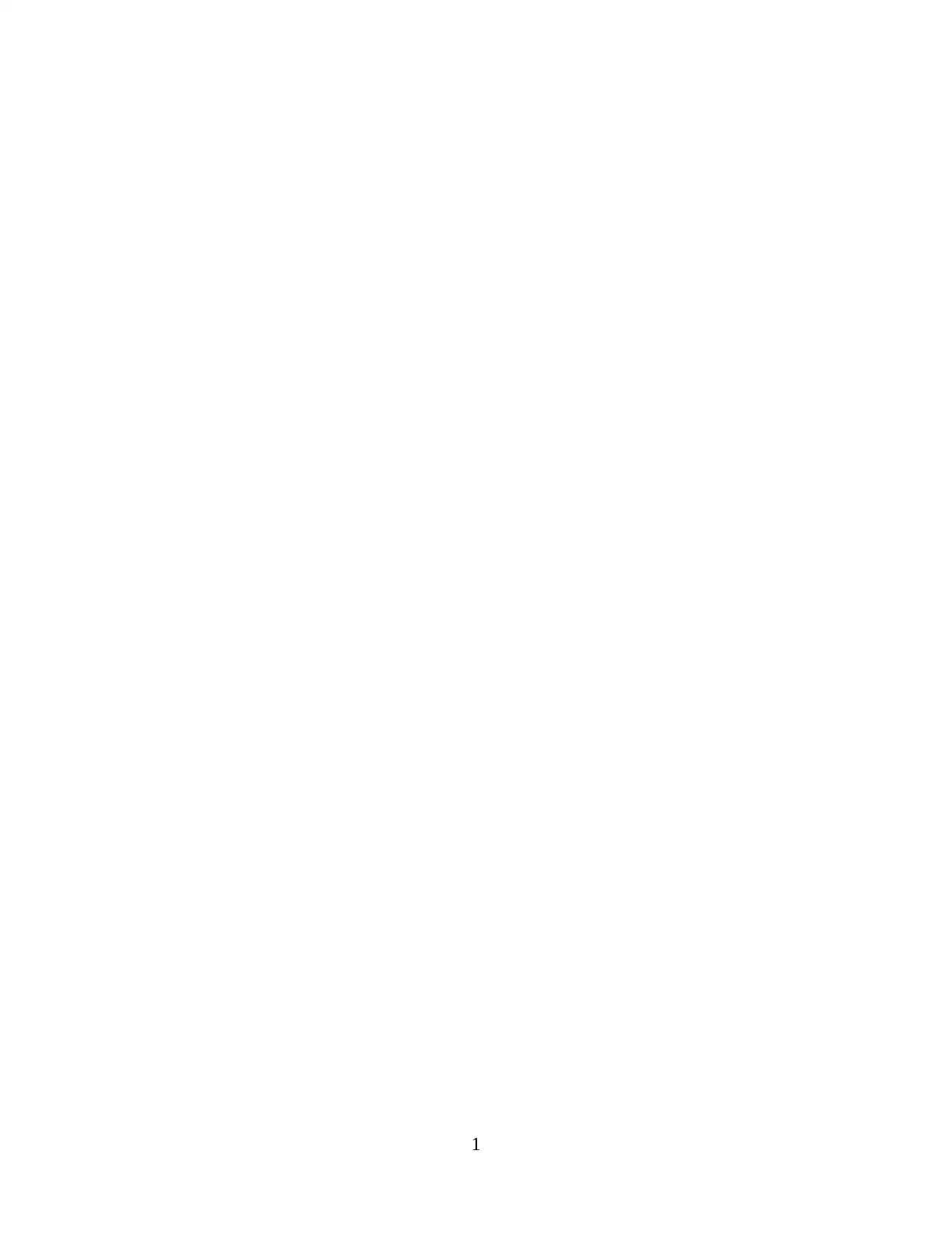
1
1 out of 11
Related Documents
Your All-in-One AI-Powered Toolkit for Academic Success.
+13062052269
info@desklib.com
Available 24*7 on WhatsApp / Email
![[object Object]](/_next/static/media/star-bottom.7253800d.svg)
Unlock your academic potential
© 2024 | Zucol Services PVT LTD | All rights reserved.




